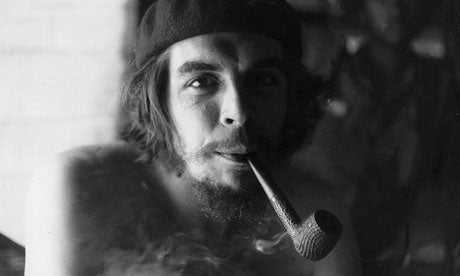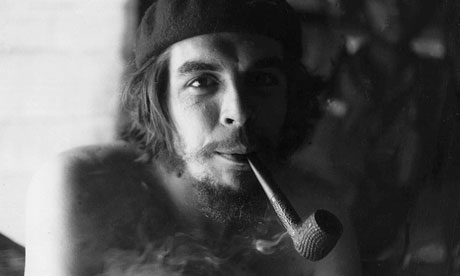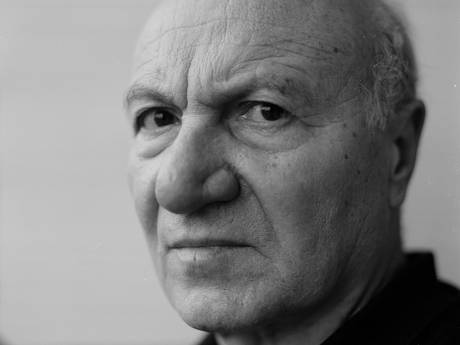Che Guevara's 'betrayer' tells his side of the story after 40 years


Ciro Bustos was 26 and at his in-laws' house for a barbecue one spring Sunday in 1958 when he first heard the voice. It belonged to a fellow Argentinian, a doctor four years his senior who was fighting alongside Fidel Castro in the mountains of south-eastern Cuba.
As he listened to the radio, the young artist was struck by the contrast between the grandiloquence of the Cuban and the quiet, almost apologetic tones of the Argentinian.
"The way Che spoke, the way he answered questions, was totally different from Castro," says Ciro, whose recollection of the broadcast has not been blunted by the intervening half-century.
"There was no bombast, no prima donna attitude. It was like talking to your brother, so normal and so calm. That was what moved me so much."
The interview Radio El Mundo carried that Sunday proved a siren call. Che Guevara's voice – and the political struggle he embodied – would lead Bustos to Cuba, Czechoslovakia, Algeria and back to Argentina before the disastrous Bolivia expedition of 1967 that would cost Che his life and blacken Bustos's name for four decades.
Until publication of his new memoir, Che Wants to See You, Bustos had been seen by many as the man who betrayed Guevara and his brothers-in-arms by sketching their faces for his interrogators, who caught him after he marched out of the Bolivian jungle on Guevara's orders.
His book is prefaced by a quote from another figure that looms large in the Argentinian psyche – Jorge Luis Borges: "Moreover, we do not know if the universe belongs to the real world or fantasy."
Given the number of accounts written by outsiders about Guevara, the accumulation of claim and counter-claim – not to mention the extraordinary experiences he and Che shared – the line felt more than a little apt, says Bustos. "All the things that happened, all the good things as well as all the mistakes, seem almost imaginary, almost made up," he says in his deep, sing-song Spanish.
Bustos shares Borges's obsession with the duality of heroism and betrayal and the book, he says, is his attempt to kill the myth that he sold out Guevara. Had any journalist bothered to find him and ask him what really happened, he adds, he would have told them the truth. As it was, no one solicited his version of events until the US reporter Jon Lee Anderson tracked him down to Malmö in 1995.
"I can't explain why the press did this but it's like the Argentinian writer Tomás Eloy Martínez said: 'Whenever there's a hero, there's a traitor.' So that's what the press created."
It is a version for which he has paid dearly. "This story," he says with wet eyes, "has cost me 40 years; 40 years of bad faith. That's why I wrote the book." As the title suggests, Bustos's book is the record of a young man's political vocation. And although it often reads like a hagiography of Guevara – Bustos marvels at his leader's strength of character and compares him to Alexander the Great and the young Napoleon – he refuses to deify him.
From their first meeting in Guevara's office in the ministry of industry in Havana, says Bustos, Che was startlingly down-to-earth. "He wasn't what I expected. He was much nicer. All I knew of him was what I saw in photographs and what I heard on the radio and in the press. But when I met him, I met a fully rounded human being totally free from pomposity. When the time was right, he had a sense of humour, too."
Guevara was sufficiently impressed with his compatriot to include him in his plans to sow revolution in their homeland. Bustos and several others were trained in insurgency in Cuba and Algeria and then sent to northern Argentina to establish a guerrilla network. Their mission, which was overseen by Jorge Ricardo Masetti, the journalist turned fighter who had interviewed Che in the Sierra Maestra five years earlier, was dogged by disaster and terrible morale. As the situation in the jungle worsened, Masetti appeared to grow ever more authoritarian, ordering the weakest members of the groups to be executed. On one occasion, Bustos had to finish off a condemned man named Pupi who was lingering too long in his death throes.
Although the memory of that day remains fresh, Bustos says he and Masetti were simply doing what had to be done. "I still think about Pupi, but there was a problem that needed to be dealt with. In a struggle where you're risking your life, the worst thing that can happen is for morale to break down. That's what happened."
Bustos emerged from the jungle to carry on building a revolutionary network in Argentina. Three years later, in 1967, Che asked him to join his guerrilla band in Bolivia, where he hoped to detonate a "continental revolution". But, like the Argentinian operation, the mission was doomed to failure: the Bolivian army soon got wind of their presence and began closing in. Bustos and the French Marxist theoretician Régis Debray, who was in the country to meet Guevara, left the guerrilla force with Che's blessing but were soon captured by the Bolivian army.
Bustos kept his interrogators at bay for three weeks, telling them he had been on his way to a conference on political prisoners when he had run across the guerrillas. But when it became clear that the CIA and the Bolivian army already knew everything – including who many of the guerrillas were – he changed tack. Bustos confirmed that he was an Argentinian artist and agreed to sketch some of the fighters to prove that he was not lying.
"I took the opportunity and drew," says Bustos. "If the guerrillas were dead anyway, what difference would it make? None. But the people who were working clandestinely [in Argentina] had to be protected."
Forty-six years after he drew the likenesses of his comrades, Bustos remains convinced that he did the right thing: "Of course I'm angry that people keep on talking about the pictures. They're picking up different bits and pieces without understanding what actually happened."
A few months later, on the day he and Debray were sentenced to 30 years in prison by a Bolivian military tribunal, Bustos learned that Guevara had been captured and executed. Hearing the news, he felt "as though the bullets that killed him had hit me, too … it was like losing a leader, a brother and a friend all at the same time".
After spending almost three years in a cage in the grounds of a military base, he and Debray were freed in December 1970 after a leftist general took power in Bolivia. After a stint in Salvador Allende's Chile, Bustos returned to Argentina only to flee to Sweden in 1976 when his life was threatened by the rightwing death squads that had begun purging the country of dissidents.
Despite his years of imprisonment and exile, Bustos has few regrets.
"The people who died paid the highest price," he says. "I survived to watch my family grow. If I could live my life over again I'd do the same things with the same people."
- the above is taken from an interview with Ciro Bustos in the Guardian. You can read the full piece here. Ciro has also been interviewed in the Independent, Daily Mirror and featured in the Daily Mail.
Che Wants to See You: The Untold Story of Che Guevara by Ciro Bustos reveals an extraordinary life of reveloution with Che Guevara. It is available to buy now.

- a photograph of Ciro Bustos, today at 81.
